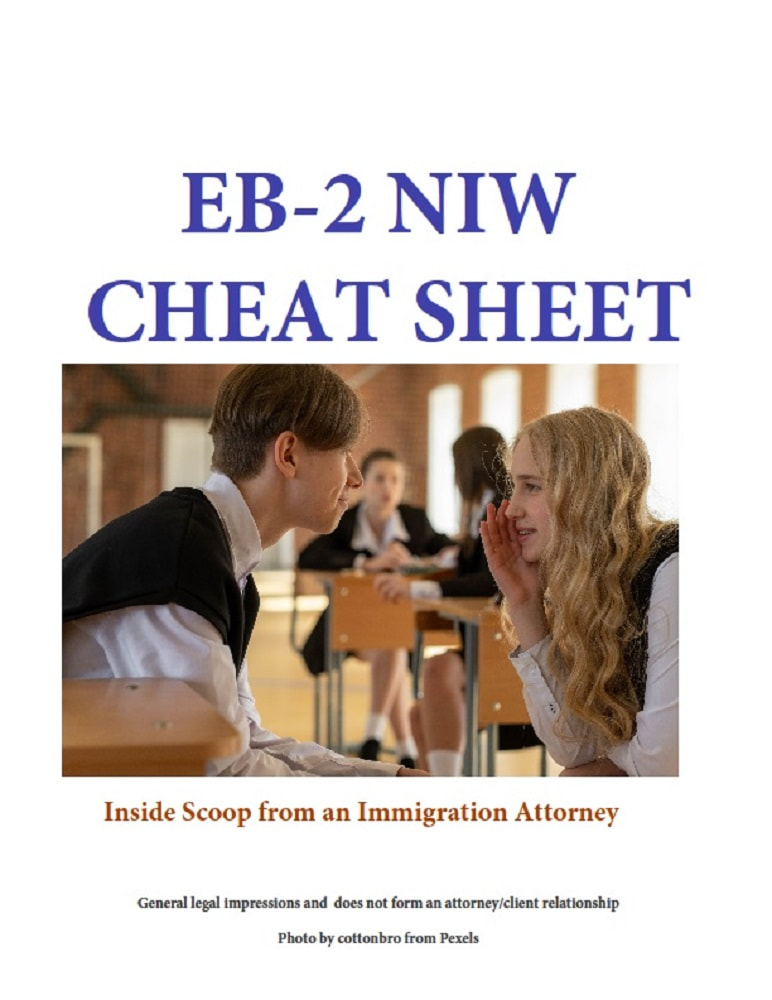 If you are a professional or a researcher, and you want to achieve a green card without a job offer or labor certification, an EB-2 national interest waiver might be for you. You might believe that your work is quite meritorious and could benefit the USA, but that may not be enough. United States Citizenship and Immigration Service (USCIS) officers tend to look for particular characteristics of a I-140 national interest waiver petition before they believe that it is approvable. Therefore, it can be beneficial to learn as much as you can about the EB-2 national interest waiver before applying for one. It is also prudent to at least consult with an immigration attorney in your area. National Merit Defined The laws regarding employment-based green cards are part of the Immigration and Nationality Act (INA). Additionally, guidance can be found in the USCIS Policy Manual. Specifically, the EB-2 NIW regulations come from a 2016 court decision called Matter of Dhanasar. That case states that national importance can be based on prospective national, or even global, impact. The Dhanasar decision also says that: “Even ventures and undertakings that have as their focus one geographic area of the United States may properly be considered to have national importance.” Ways to Show National Merit for an EB-2 NIW USCIS officers will not likely put much weight on statements that the applicant makes about the national importance of their own work. More objective evidence can be more persuasive. Find Some News Articles Locating articles in mainstream publications, such as Newsweek, Forbes, or Time can be one way to show national importance. Many EB-2 NIW beneficiaries like to print out the articles to send to USCIS with the petition letter. Another idea is to provide links to the articles within the text of the petition letter. As it stated in the Dhanasar case, endeavors that are newsworthy on a regional level may qualify as being nationally important. Executive and Legislative Branches Checking websites like whitehouse.gov or congress.gov can be helpful resources for establishing national importance. For example, the White House website has links to presidential proclamations and executive orders. The Congress website shows bills that are currently being discussed on the House and Senate floors. There are also items from past congressional records, as well. Letters of Recommendation Although they may be considered less objective, since most EB-2 NIW applicants ask for the letters, a recommender might include examples of the national importance of an I-140 beneficiary’s work. These might be used to supplement other evidence. Be sure to have letters of recommendation printed on letterhead. It is also preferable they include the date of signature. Check with an Immigration Attorney Near You Although you can self-petition for an EB-2 NIW, it is no easy task. Consulting with someone who drafts this type of petition letter on a regular basis can be extremely helpful.  Imagine your excitement when you finally receive mail from the United States Citizenship and Naturalization Service (USCIS). Then think of how crestfallen you might feel when you find a Request for Evidence (RFE) letter inside the envelope. Receiving an RFE letter can be extra frustrating if you have already been waiting months for some sort of response from USCIS on your case. Nevertheless, responding to an RFE can be an opportunity to make sure that your petition is approvable by a USCIS officer. What’s an RFE? Foreign nationals who have never heard of an RFE should consider themselves lucky. If you “Ask Emma” about them on the USCIS website, here is what she will say: "A request for evidence (RFE) is made when an application or petition is lacking required documentation (initial evidence), or the officer needs more documentation (additional evidence) to determine an applicant's eligibility for the benefit sought. We may send you a request for evidence at any stage of our review. The request will indicate what evidence or information is needed for us to fully evaluate your application or petition. The notice will explain where to send the evidence and will give the deadline for your response. Your application or petition will be held in suspense during that time. If you receive a request for evidence and have questions about what you need to submit, you may call our USCIS Contact Center at 1-800-375-5283." So, basically, an RFE is the Department of Homeland Security’s way of making sure that they have everything they need to approve a case. However, sometimes, an RFE can be a stall tactic on the part of USCIS. REQUEST FOR EVIDENCE DURING PREMIUM PROCESSING Certain immigration petitions and applications, such as for the EB-1A extraordinary ability green card and the E-2 treaty investor nonimmigrant visa allow applicants to submit Form I-907 to request premium processing. Paying an additional $2,500 for premium processing means that a USCIS officer must “act” on the case within 15 calendar days. However, frequently this speedy processing means the issuance of an RFE, or worse, a Notice of Intent to Deny (NOID). The bright side is that beneficiaries of more complex cases, such as the EB-1A or the E-2, can treat the initial application sort of like a practice exam. They can use the RFE letter as a form of cheat sheet to see exactly what they must do to “pass” the test by getting an approval. GETTING AN RFE AFTER YOU FILED THE CASE YOURSELF Some noncitizens prefer to petition for an EB-1A, an EB-2 NIW, or an E-2 themselves in order to save money. But, as a colleague once quipped, “Just because I can put a new transmission in my car myself doesn’t mean that I will feel safe driving it afterwards.” There is a reason that people get surgery from people who went to medical school and highlights from licensed beauty professionals. To do otherwise can mean disaster. If you tried to file your immigration case yourself and received a NOID or RFE from USCIS, you can still save your case. Many immigration law firms near you are willing to take you on as a client and respond to your RFE. Bona Fide Enterprise for E-2 Visa Purposes
Even if you come from a qualifying treaty country and have substantial, investable capital, your USCIS E-2 visa application could be denied if it fails to establish that the proposed or existing business is a bona fide enterprise. As such, an E-2 visa applicant should submit supplemental evidence that the enterprise meets E-2 visa criteria. The USCIS E-2 visa standards require that the enterprise is a real, active, and operating commercial or entrepreneurial venture that produces goods or services for profit. To demonstrate that the investor has the requisite commitment to the enterprise, the E-2 visa applicant might provide USCIS with a detailed description of the activities of the business, as well as financial statements and business reports. Other examples of evidence that may prove to USCIS that the proposed or existing enterprise qualifies as a bona fide venture include the following:
The USCIS requires that an E-2 visa applications be for a bona fide venture in the USA, and not a marginal enterprise. As such, it can be important for you provide them with sufficient documentation to demonstrate that the enterprise is bona fide. A marginal enterprise, as defined by the USCIS, is one that does not have the current or potential capacity to generate more than enough income for the treaty investor and their E-2 visa dependents. A persuasive E-2 visa application should demonstrate that the treaty investor’s income will be more than sufficient for at least five years from the date of the E-2 visa classification. The USCIS could deny an E-2 visa application if it determines that the proposed or existing enterprise is derived from relatively small capital and is intended only to provide a living for the investor and their E-2 dependents. One method of fortifying an E-2 application is by submitting a detailed business plan or executive summary. Additional documentation that may convince the USCIS that a treaty investor business is bona fide, rather than marginal, includes following:
|
Photos from shixart1985 (CC BY 2.0), themostinept, Cold, Indrid, Alexandre Dulaunoy, radkuch.13, Phillip Pessar, SchuminWeb, themostinept, EpicTop10.com, wuestenigel, DonkeyHotey, wwarby, hile, PEO, Assembled Chemical Weapons Alternatives, Aidan Jones, oliff11, Michael C. Rael, Unique Randomness, wuestenigel, Jonathan Rolande, wuestenigel, shixart1985, byzantiumbooks





 RSS Feed
RSS Feed




